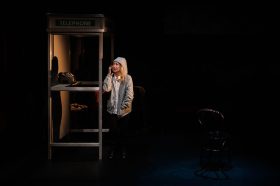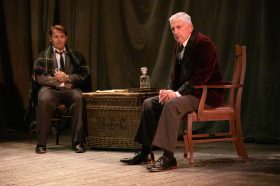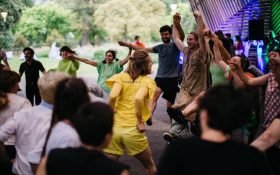The latest 2014 New Music Network concert featured the musicians of the Kammer Ensemble in solo, duet and quintet formats. It continued this ensemble’s agenda of bringing recent Australian music to audiences alongside other international contemporary works. This concert had at its conclusion a version of Arnold Schoenberg’s revolutionary Kammersymphonie Opus 9 and works from three other countries. A quintet by Chinese-American composer Zhou Long was performed alongside works for solo or duet by Australian Paul Stanhope and British composer Peter Maxwell-Davies.
Schoenberg’s important chamber work as arranged for mixed quintet by Anton Webern was a dramatic and intense conclusion to this concert.The individual talents of the instrumentalists combined to present Schoenberg’s contemporary classic in a bold and robust way. The Kammer Ensemble launched into this single movement work with a vibrant tempo and with a strong presentation of motifs. The ensuing sections of calmer nature were well contrasted.
It was quite thrilling to witness the Kammersymphonie pared down from the original 15 instruments to a quintet, as arranged in 1923 by Schoenberg’s student Webern. In this performance the quintet’s moments of full texture and tone colour suggested the sound and energies of a larger group. The members of the quintet cleanly outlined their individual parts of Schoenberg’s busy texture. A forward momentum catapulted the focussed interpretation to its exciting climax, crowning it as a highlight of this concert.
Preceding this offering of importing chamber music history was a solo cello piece by Australian Paul Stanhope. Dawn Lament (1999), with both intimate and expansive playing by cellist Andrew Hines, is based on the poem ‘Dawn Wail for the Dead’ by Oodgeroo Noonuccal. This provided an expressive interlude. Its identity as an Australian work satisfied the priorities of both the Kammer Ensemble and New Music Network.
Versatility and the deft delivery of modern instrumental techniques were displayed throughout the remainder of this concert. Dhyana by Zhou Long, premiered in 1990 and challenges the performers to make their Western instruments resemble those from traditional China. This work also has a complex texture featuring the handling of small fragments and independent direction of parts. These concerns were in good hands on this night, and a pure meditative atmosphere still prevailed. Stephanie McCallum’s work shifting in and out of the piano to pluck or stop strings in the style of a zither as well as play passages on the keyboard was a busy, precise and well-balanced part of the soundscape.
The evening opened promisingly with a duet for flute and bass clarinet, Peter Maxwell Davies’ Veni Creator Spiritus (2002), an elaboration on the plainchant melody. This choice of opening work was a satisfying opening to this new music program. Lisa Osmialowski’s control and delivery of modern articulation and key slapping techniques were an interesting feature. The balance between the flute and John Lewis’ bass clarinet was exquisite and delicate. This balance with extremes of register, breath noises and precise accentuation from the pair to deliver Maxwell-Davies’ inventive reworking of ancient music was a fine beginning to an entertaining night of new music, with performances of an inspired standard.
Kammersymphonie by The Kammer Ensemble was performed on Friday 17 October 2014 at St Mary’s Cathedral Chapter Hall, Sydney, as part of the New Music Network series 2014
Lisa Osmialowski: Flute
John Lewis: Clarinet
Huy-Nguyen Bui: Violin
Andrew Hines: Violoncello
Stephanie McCallum: Pianoforte





